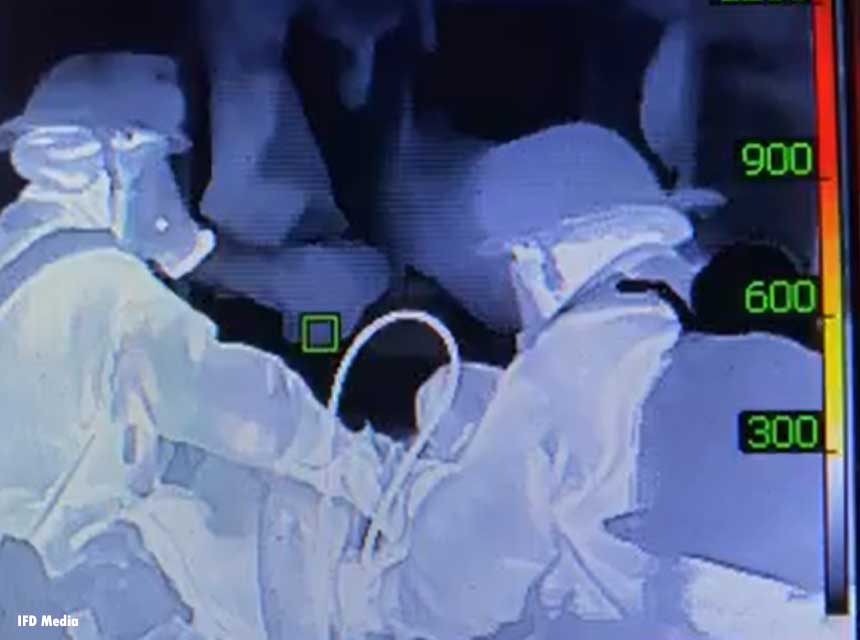
In the fire service, our equipment evolves along with technology. One such piece of equipment is the thermal imager (TI). This technology adapted from the military allows the firefighter to be able to get a clearer image of the room, layout of a structure, victim locations, convection currents, all within zero-visibility environments.
The TI is usually the last piece of equipment that is grabbed by a firefighter or an officer. It is not thought of as an essential piece of equipment, but it is. It should be the first thing grabbed by both the officer and firefighter. The officer should have the TI when leading in the crew, as it will allow them to direct their crew’s efforts in a more effective way. If there is no officer with the crew, then one firefighter should have it.
Standard operating guidelines can have a place with this as it can require/suggest who will bring in the TI. Having the TI with you during interior operations will greatly enhance the overall safety of the crew and allow for a more expedient operation.
Besides interior fire operations, the TI can be used at any call we respond to. In the case of a vehicle accident, the TI can be used to determine the number of people seated in the vehicle—by reading the heat signature on the seats. It can be used for doing a size-up while walking around a structure—it will highlight the convection currents exiting the structure and pinpoint the location of the fire from the outside.
RELATED FIREFIGHTER TRAINING
THERMAL IMAGING FOR THE FIRE SERVICE: THE BASICS OF THERMAL IMAGING
The Thermal Imaging Camera (TIC) and the Fire Service, Part I | Part II
On a hazardous materials call, it can be used to determine if the container is full or empty by reading the heat signature of the liquid in relation to the container. For example, if it was half full, there will be a black image showing from the halfway mark and down with a lighter image showing from the halfway point and up.
On a search call outside for a missing person, the TI can be used to help pinpoint the person both during the daytime and at nighttime. When used in a rapid intervention team (RIT) situation for locating a downed firefighter, the TI can be used to determine if the firefighter is breathing or not. The low-pressure hose going to the regulator should be black in color in the image along with the cylinder.
There are numerous applications that the TI can be used for on both the emergency call and the non-emergency calls. Knowing how to use the TI is the key and that will only come with practice, trial and error, and training.
Equipment needed: Thermal imager
Goal: To become familiar with the TI assigned to the apparatus.
Drill:
- Fill a metal or plastic 55-gallon drum with water about halfway up.
- Using the TI, scan the drum to determine if it is halfway full – the image should appear black from the halfway mark down.
- Take a firefighter and dress them up in their SCBA. Have them go on air and lie down on the ground.
- Using the TI, scan the downed firefighter to see if there is air movement in the low-pressure hose going to the regulator. The hose will appear black in the image and can be traced back to the cylinder.
- Have a few firefighters sit in a vehicle’s seats for a while. After they have gotten out of the vehicle, use the TI to scan the seats of the vehicle to determine the number of occupants.
- Using the TI, walk around the fire station and scan the building. Looking at the image on the screen, read the building in terms of heat exiting the structure from natural air currents.
Key points:
- Become familiar with the TI that your department uses. Know what the functions are and how to navigate through them if equipped.
- Always take the TI with you on every call. It is a useful tool that will aid in the situation being rectified.

Mark van der Feyst has been in the fire service since 1999 and is a firefighter with the Fort Gratiot (MI) Fire Department. He is an international instructor teaching in Canada, the United States, and India, and at FDIC. He is also the lead author of Residential Fire Rescue (Fire Engineering Books & Video). He can be contacted at Mark@FireStarTraining.com.
MORE
Firefighting Basics: Heel from the Front
Firefighting Basics: Aggressive Cooling and Vertical Ventilation

